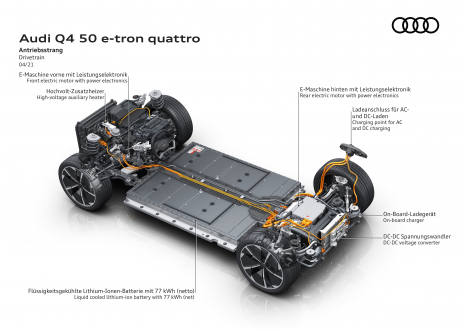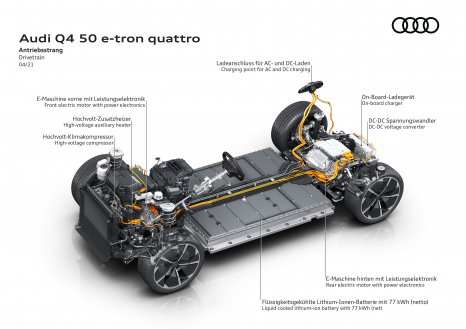Audi Q4 e-tron – Charging management
Stable temperature conditions: more power when driving and charging
The thermal management system aims to get the battery up to the ideal temperature range of around 30 degrees Celsius quickly after it is started and to keep it there until the end of the journey. This ensures that its full power – and therefore the power of the entire drive system – is available after a short time even in extremely cold conditions. Thanks to the stable thermal conditions, the driver can also call on it repeatedly or charge the battery at an HPC charging terminal with high output. The sophisticated thermal management system also gives the battery a long life cycle – Audi guarantees that it will still have at least 70 percent capacity after eight years of operation or after 160,000 kilometers.
The interior climate is controlled using a coolant circuit with a compressor, condenser, and evaporator. Valves connect it to the drive circuits when these require an unusually high level of cooling. This can happen during high power requirements but also during fast HPC charging with direct current, which causes the battery to heat up significantly.
Strengths for every day: range and high charging capacity
All model and motor versions of the Audi Q4 e-tron and the Q4 Sportback e-tron have a CCS (combined charging system) on board. This system enables the SUVs to be charged with alternating current (AC) and direct current (DC), the latter at powerful HPC (high-power charging) terminals. In ideal conditions the Q4 40 e-tron** can recharge enough electricity to cover about 130 kilometers (80.8 miles) (WLTP) in around ten minutes.
The optional compact e-tron charging system can be used for alternating current charging at home using 230 volts or the 400 volts recommended by Audi. The Q4 35 e-tron (combined electric power consumption in kWh/100 km (62.1 mi)*: 16.7 – 15.8 (NEDC), combined CO2 emissions in g/km*: 0) can charge at a capacity of up to 7.4 kW, and the other models at up to 11 kW. The e-tron charging system connect, which will be released toward the end of the year, features smart charging functions in interaction with a home energy management system. These include charging at times when electricity is less expensive or using solar power if a photovoltaic system is installed.
On the road, the standard mode 3 cable is used for charging with alternating current at AC terminals.
* Information on electric power consumption and CO2 emissions figures given in ranges depend on the equipment selected for the vehicle.
** The collective fuel/electric power consumption values for all models named and available on the German market can be found in the list provided at the end of this press release.
Audi Q4 40 e-tron: Combined electric power consumption in kWh/100 km (62.1 mi)*: 19.3–17.3 (WLTP); 17.3 – 16.3 (NEDC) Combined CO2 emissions in g/km: 0
04/2021

